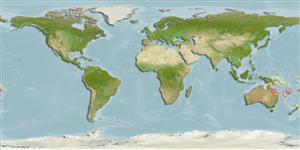Actinopterygii (ray-finned fishes) >
Perciformes (Perch-likes) >
Pomacanthidae (Angelfishes)
Etymology: Chaetodontoplus: Greek, chaite = hair + Greek, odous = teeth + Greek, plous, ous, oo = crossing (Ref. 45335).
Environment / Climate / Range
Ecology
Marine; reef-associated; non-migratory; depth range 1 - 40 m (Ref. 9710). Temperate, preferred ?
Western Pacific: southern Great Barrier Reef (Australia) and New Caledonia, southward to Lord Howe Island.
Size / Weight / Age
Maturity: Lm ? range ? - ? cm
Max length : 10.0 cm TL male/unsexed; (Ref. 9710)
Dorsal
spines
(total): 13;
Dorsal
soft rays
(total): 18;
Anal
spines: 3;
Anal
soft rays: 18. Blue gray on upper half of body, brown to blackish on ventral half. Operculum and basal part of pectoral and caudal fins yellow; snout and outer part of the pectoral and caudal fins black; lips, pelvic fins whitish or light blue. Eye with blue ring; margin of preopercle and opercle blue.
Generally inhabits deep coral reef areas. Juveniles as shallow as 1 m on lagoon reefs (Ref. 9710). Feeds on sponges and tunicates. Forms pairs. Rarely exported through the aquarium trade (Ref. 48391).
Life cycle and mating behavior
Maturity | Reproduction | Spawning | Eggs | Fecundity | Larvae
Randall, J.E., G.R. Allen and R.C. Steene, 1990. Fishes of the Great Barrier Reef and Coral Sea. University of Hawaii Press, Honolulu, Hawaii. 506 p. (Ref. 2334)
IUCN Red List Status (Ref. 115185)
CITES (Ref. 94142)
Not Evaluated
Threat to humans
Harmless
Human uses
Aquarium: commercial
More information
Common namesSynonymsMetabolismPredatorsEcotoxicologyReproductionMaturitySpawningFecundityEggsEgg development
ReferencesAquacultureAquaculture profileStrainsGeneticsAllele frequenciesHeritabilityDiseasesProcessingMass conversion
Tools
Special reports
Download XML
Internet sources
